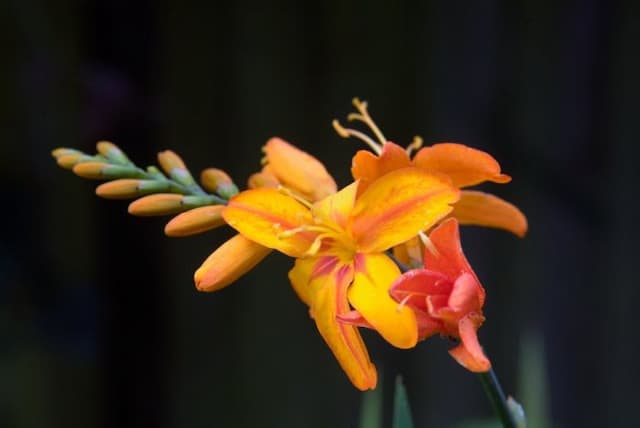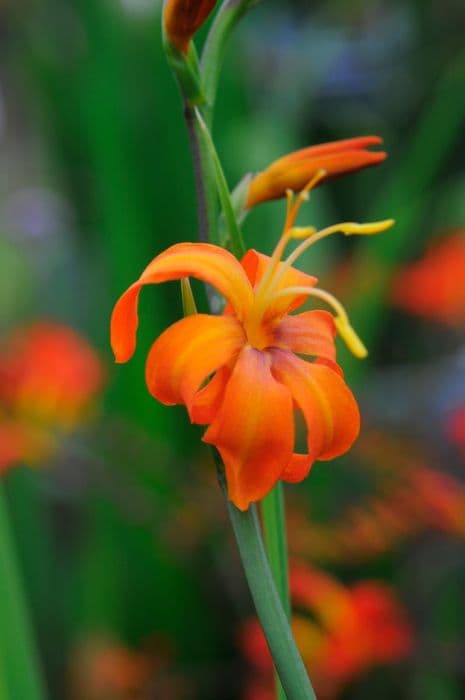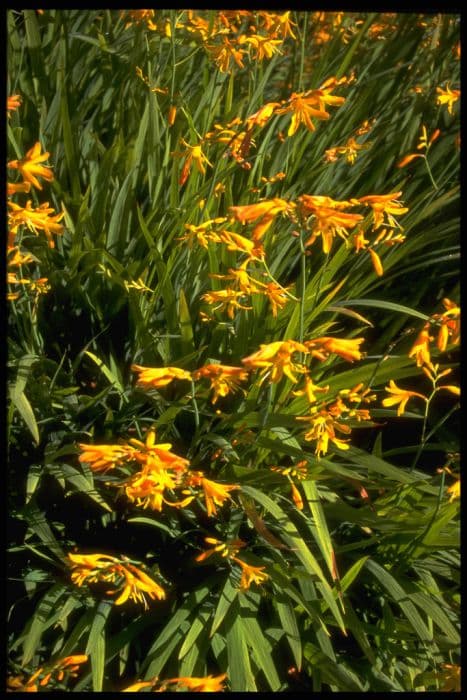Dwarf Iris Iris 'Morning's Blush' (SDB)
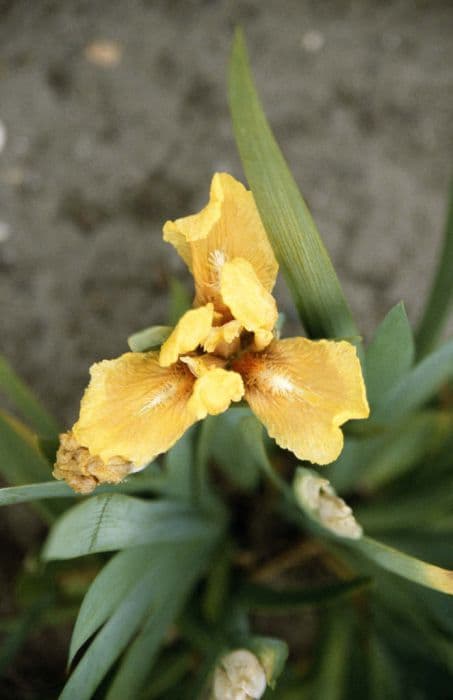
ABOUT
Iris 'Morning's Blush' is a striking plant characterized by its unique and eye-catching flowers. The blooms display a soft palette, typically showcasing shades of pale pink, lavender, or peach, which can remind one of the gentle hues of a sunrise. The flowers possess the classic iris form with three upright 'standards,' which are the petals that rise vertically, and three drooping 'falls,' which are the sepals that drape downwards. These falls may have a slightly ruffled or waved edge, adding to the plant’s delicate charm. At the base of each fall, there's often a contrasting 'beard,' a plush line of fuzz that can be a vibrant yellow or orange, giving a pop of color against the softer background of the flower's petals. The foliage consists of slender, sword-like leaves arranged in a fan-like pattern, typically a rich, vibrant green which forms an elegant backdrop to the stunning flowers. The allure of the Iris 'Morning's Blush' lies in its soft color palette coupled with the classic iris floral structure, making it a beautiful addition to any garden where it adds a touch of gentle, pastel elegance.
About this plant
 Names
NamesFamily
Iridaceae
Synonyms
Standard Dwarf Bearded Iris, SDB Iris
Common names
Iris 'Morning's Blush' (SDB).
 Toxicity
ToxicityTo humans
The Iris 'Morning's Blush' (SDB), commonly referred to as Dwarf Bearded Iris, is not generally considered highly toxic to humans. However, like many irises, it does contain compounds that can cause irritation or allergic reactions in some people. If ingested, the rhizomes (the underground stems) are the most toxic part of the plant. Eating large quantities of the rhizomes may result in gastrointestinal disturbances such as nausea, vomiting, abdominal pain, and diarrhea. Handling the plant could also occasionally cause skin irritation or allergic reactions.
To pets
The Dwarf Bearded Iris, which is the common name for Iris 'Morning's Blush' (SDB), can be toxic to pets if ingested, particularly the rhizomes. The primary toxic substances in these plants are irisin, iridin, or irisine, which can cause symptoms such as drooling, vomiting, diarrhea, lethargy, and abdominal pain in animals. In severe cases, ingestion may lead to more serious effects, including potential organ damage. It is important to keep pets away from eating any part of these plants to prevent poisoning.
 Characteristics
CharacteristicsLife cycle
Perennials
Foliage type
Deciduous
Color of leaves
Green
Flower color
Pink
Height
1 foot (30 cm)
Spread
1 foot (30 cm)
Plant type
Bulb
Hardiness zones
4
Native area
Europe
Benefits
 General Benefits
General Benefits- Easy to Grow: Iris 'Morning's Blush' is known for being low maintenance and easy to care for, making it an excellent choice for both experienced and novice gardeners.
- Drought Tolerant: Once established, this plant can tolerate periods of low water, reducing the need for frequent watering.
- Attracts Pollinators: The flowers of the Iris 'Morning's Blush' attract bees, butterflies, and other beneficial insects that aid in pollination.
- Seasonal Interest: With its striking flowers that bloom in the spring, the plant adds seasonal color and interest to gardens and landscapes.
- Cold Hardy: This type of Iris can withstand cold temperatures, making it suitable for growth in a range of climates.
- Deer Resistant: Iris 'Morning's Blush' is not a preferred food source for deer, reducing the likelihood of damage from grazing.
- Multiplication: This plant multiplies over time, allowing gardeners to divide and share the rhizomes with friends or to expand their own garden displays.
- Architectural Structure: The distinctive shape and height of the Iris 'Morning's Blush' provide a unique architectural element to garden designs.
- Soil Adaptability: Can adapt to a range of soil conditions, though it prefers well-drained soils.
 Medical Properties
Medical PropertiesThis plant is not used for medical purposes.
 Air-purifying Qualities
Air-purifying QualitiesThis plant is not specifically known for air purifying qualities.
 Other Uses
Other Uses- Artistic inspiration: The Iris 'Morning's Blush' can be used by artists as a subject for paintings, drawings, and photography due to its striking appearance and delicate gradation of colors.
- Educational tool: Horticulture educators may use the Iris 'Morning's Blush' to teach students about plant genetics, hybridization, and the specific needs of different iris varieties.
- Culinary decoration: The petals of 'Morning's Blush' can be used as edible decorations on cakes and desserts, adding an elegant touch to culinary presentations.
- Fragrance extraction: Although not commonly known for their scent, the subtle fragrance of Iris 'Morning's Blush' can be extracted and used in perfumery and scented products.
- Textile dye: The petals of 'Morning's Blush' can potentially be used to create natural dyes for textiles, offering a sustainable alternative to synthetic dyes.
- Indicator of climate change: As a sensitive plant, the blooming period of Iris 'Morning's Blush' can be studied by researchers as an indicator of the local effects of climate change.
- Wedding decor: Because of its beauty and grace, Iris 'Morning's Blush' can be utilized in wedding bouquets, centerpieces, and decorations, offering a unique and soft color theme.
- Floral jewelry: The petals and buds of the 'Morning's Blush' can be incorporated into floral jewelry pieces, such as earrings and necklaces, for a natural and organic accessory option.
- Crafting and scrapbooking: Pressed flowers of Iris 'Morning's Blush' can be used in crafting projects, such as scrapbooking, greeting cards, or bookmark making for a delicate touch of nature.
- Symbolic gift: Due to the iris being a symbol of wisdom and hope, 'Morning's Blush' can be given as a gift to represent these meanings in a more personal and specific manner.
Interesting Facts
 Feng Shui
Feng ShuiThe Iris is not used in Feng Shui practice.
 Zodiac Sign Compitability
Zodiac Sign CompitabilityThe Iris is not used in astrology practice.
 Plant Symbolism
Plant Symbolism- Faith: The iris is often associated with faith and hope, embodying a sense of trust in the future and spiritual beliefs.
- Wisdom: Historically, the iris is a symbol of wisdom and valued for its association with knowledge and learning.
- Courage: Especially in ancient Greece, the iris is linked to courage, commemorating the valor and bravery of warriors.
- Royalty: With its regal appearance, the iris often represents royalty and nobility, denoting sovereignty and regal majesty.
- Purity: The iris can also symbolize purity, with its clear, delicate hues imparting a sense of innocence and cleanliness.
- Hope: The iris, through its perennial nature and ability to bloom anew, acts as a symbol for hope and new beginnings.
 Water
WaterDwarf Bearded Iris should be watered deeply once a week during their active growth period, particularly if the weather is dry. As a general guideline, provide about an inch of water, which roughly translates to 0.6 gallons per square foot, every week. It’s crucial to avoid overwatering as these plants prefer drier conditions once established. During the hotter, drier periods, increase watering slightly. In the winter, reduce watering significantly as the plant goes dormant and requires less moisture.
 Light
LightDwarf Bearded Iris thrives best in full sunlight, requiring at least six hours of direct sunlight daily. The ideal spot for planting would be a location where they can receive morning sun and some afternoon shade, especially in hotter climates. However, too much shade can lead to poor flowering, so it’s important to ensure a bright environment for the best growth and bloom results.
 Temperature
TemperatureDwarf Bearded Iris is a hardy plant that prefers cooler temperatures but can survive in temperatures ranging from about 14°F to 86°F. Their ideal growth temperature is between 35°F and 70°F. Extended periods of heat above this range can stress the plant, while temperatures well below freezing can damage or kill it.
 Pruning
PruningDwarf Bearded Iris should be pruned to remove any dead or damaged foliage and spent flower stalks. This encourages healthy growth and reduces the risk of disease. Prune after blooming, cutting back flower stems to the base. Additionally, divide and tidy up the clumps every three to five years to prevent overcrowding; the best time to do this is late summer after flowering.
 Cleaning
CleaningAs needed
 Soil
SoilDwarf Bearded Iris prefer well-drained soil with a pH of 6.8 to 7.0. A mix of loamy garden soil, compost, and sand or perlite to enhance drainage is ideal for promoting healthy growth.
 Repotting
RepottingDwarf Bearded Iris should be repotted or divided every 3 to 4 years to ensure vigor and to prevent overcrowding, ideally in late summer after blooming.
 Humidity & Misting
Humidity & MistingDwarf Bearded Iris thrive in outdoor conditions where humidity is generally not a concern; however, for optimal growth, they prefer average humidity levels without excessive moisture.
 Suitable locations
Suitable locationsIndoor
Ensure bright light, well-draining soil, and good air circulation.
Outdoor
Plant in full sun, moderate water, well-draining soil, spaced out.
Hardiness zone
3-9 USDA
 Life cycle
Life cycleThe life cycle of the Iris 'Morning's Blush' (Standard Dwarf Bearded Iris), begins with seed germination, where the seeds require stratification to break dormancy. Once germinated, the seedlings develop into young plants with characteristic narrow, sword-like leaves. After a period of vegetative growth, they establish rhizomes, which are horizontal underground stems that store nutrients and aid in asexual reproduction. The plant reaches maturity and blooms in late spring to early summer, showcasing its delicate pink and lavender flowers. Post-blooming, the flowers wither, and the plant sets seed while the foliage continues to photosynthesize and replenish the rhizomes. As winter approaches, the plant becomes dormant, with the rhizomes surviving underground until favorable conditions return in the spring, restarting the cycle.
 Propogation
PropogationPropogation time
Early Summer
Propogation: The most popular method of propagating the Iris 'Morning's Blush', a Standard Dwarf Bearded Iris, is by division. This is generally done after the flowering period, which is late spring to early summer. To propagate by division, lift the clump of iris rhizomes from the ground every 3 to 5 years, preferably in late summer when the weather begins to cool down. Using a sharp knife, separate the rhizomes, ensuring that each division has one or two leaf fans. Trim the leaves to about one-third of their original length (to approximately 4-6 inches or 10-15 centimeters) to reduce water loss. Replant the divisions about 12 to 24 inches apart (30 to 61 centimeters), with the tops of the rhizomes exposed to the air, in well-draining soil in a sunny location. This will encourage the rhizomes to establish and produce new plants, which will continue to bloom the following spring.
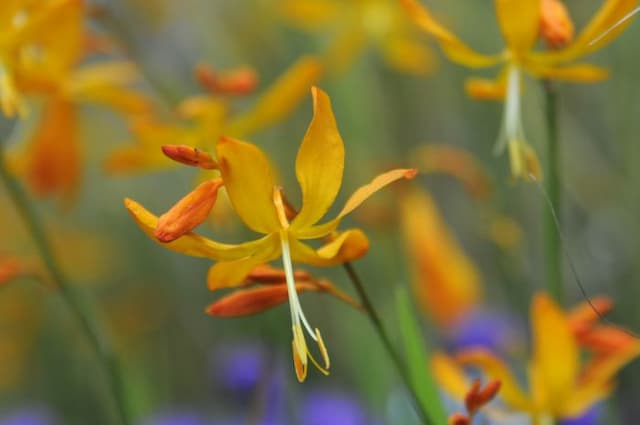
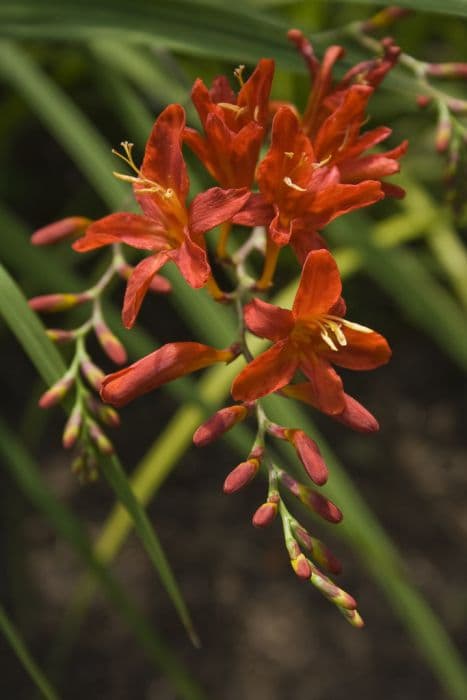
![Montbretia [Bright Eyes]](/_next/image?url=https%3A%2F%2Fplants-admin.emdemapps.com%2Fimages%2Fplants%2F%2Fimages%2F604b5f4a483b6.png&w=640&q=75)
